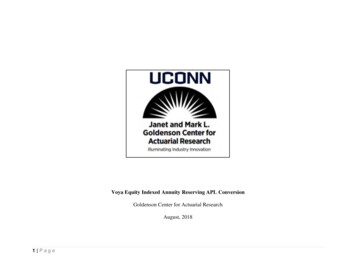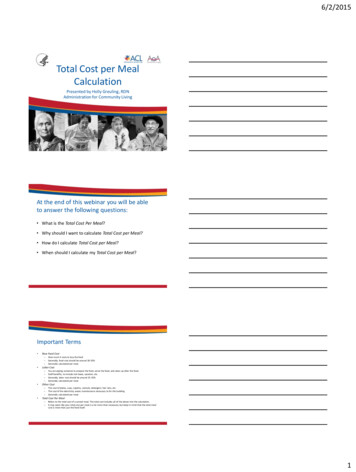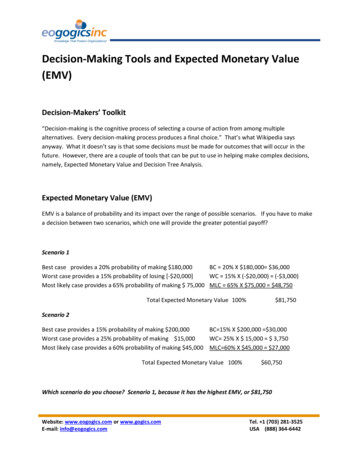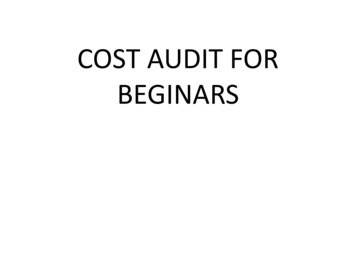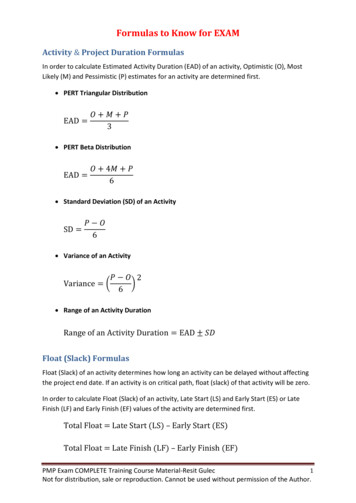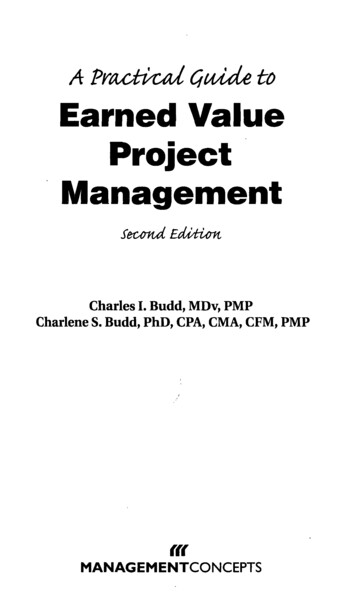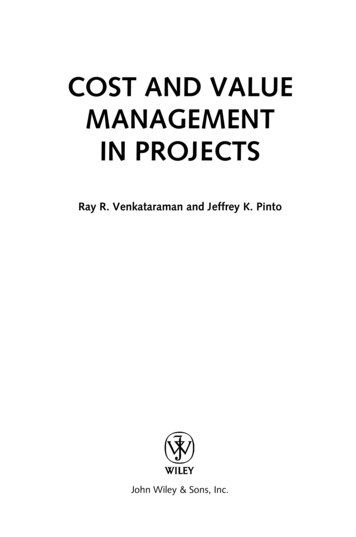
Transcription
COST AND VALUEMANAGEMENTIN PROJECTSRay R. Venkataraman and Jeffrey K. PintoJohn Wiley & Sons, Inc.
This book is printed on acid-free paper.Copyright 2008 by John Wiley & Sons, Inc. All rights reserved.Published by John Wiley & Sons, Inc., Hoboken, New Jersey.Published simultaneously in Canada.No part of this publication may be reproduced, stored in a retrieval system, or transmittedin any form or by any means, electronic, mechanical, photocopying, recording, scanning, orotherwise, except as permitted under Section 107 or 108 of the 1976 United StatesCopyright Act, without either the prior written permission of the Publisher, orauthorization through payment of the appropriate per-copy fee to the Copyright ClearanceCenter, Inc., 222 Rosewood Drive, Danvers, MA 01923, 978-750-8400, fax 978-646-8600, oron the web at www.copyright.com. Requests to the Publisher for permission should beaddressed to the Permissions Department, John Wiley & Sons, Inc., 111 River Street,Hoboken, NJ 07030, (201) 748-6011, fax (201) 748-6008, or online athttp://www.wiley.com/go/permissions.Limit of Liability/Disclaimer of Warranty: While the publisher and author have used theirbest efforts in preparing this book, they make no representations or warranties withrespect to the accuracy or completeness of the contents of this book and specificallydisclaim any implied warranties of merchantability or fitness for a particular purpose. Nowarranty may be created or extended by sales representatives or written sales materials.The advice and strategies contained herein may not be suitable for your situation. Youshould consult with a professional where appropriate. Neither the publisher nor authorshall be liable for any loss of profit or any other commercial damages, including but notlimited to special, incidental, consequential, or other damages.For general information on our other products and services please contact our CustomerCare Department within the U.S. at 800-762-2974, outside the U.S. at 317-572-3993 orfax 317-572-4002.Wiley also publishes its books in a variety of electronic formats. Some content that appearsin print, however, may not be available in electronic books. For more information aboutWiley products, visit our Web site at www.wiley.com.Library of Congress Cataloging-in-Publication Data:Venkataraman, Ray R.Cost and value management in projects / Ray R. Venkataraman and Jeffrey K.Pinto.p. cm.Includes bibliographical references and index.ISBN 978-0-470-06913-4 (cloth)1. Project management. 2. Cost control. 3. Value analysis (Cost control)I. Pinto, Jeffrey K. II. Title.HD69.P75V46 2008658.4 04—dc22a2007024563Printed in the United States of America.10 9 8 7 6 5 4 3 2 1
Contents1Introduction to the Challenge of Cost and ValueManagement in Projects11.12Importance of Cost and Value Managementin Projects1.2Keys to Effective Project Cost Management1.3Essential Features of Project Value Management1.4Organization of the BookReferences268914Project Needs Assessment, Concept Development,and Planning172.12.22.32.42.53Needs IdentificationConceptual DevelopmentThe Statement of WorkProject PlanningProject Scope Definition2.5.1 Purpose of the Scope Definition Document2.5.2 Elements of the Scope Definition Document2.5.3 Project Scope Changes2.6Work Breakdown Structure2.6.1 Types of Work Breakdown Structures2.6.2 Work Breakdown Structure Development2.6.3 Coding of Work Breakdown Structures2.6.4 Integrating the WBS and the Organization2.6.5 Guidelines for Developing a Work 3838Cost Estimation433.13.24445Importance of Cost EstimationProblems of Cost Estimationv4242
vi4Contents3.33.43.5Sources and Categories of Project CostsCost Estimating MethodsCost Estimation Process3.5.1 Creating the Detailed Estimate3.6Allowances for Contingencies in Cost Estimation3.7The Use of Learning Curves in Cost t 394959596979899Issues in Project BudgetingDeveloping a Project Budget4.2.1 Issues in Creating a Project Budget4.3Approaches to Developing a Project Budget4.3.1 Top-down BudgetingTop-down Budgeting: AdvantagesTop-down Budgeting: Disadvantages4.3.2 Bottom-up BudgetingBottom-up Budgeting: AdvantagesBottom-up Budgeting: Disadvantages4.4Activity-based Costing4.4.1 Steps in Activity-based Costing4.4.2 Cost Drivers in Activity-based Costing4.4.3 Sample Project Budget 14.4.4 Sample Project Budget 24.5Program Budgeting4.5.1 Time-phased Budgets4.5.2 Tracking Chart4.6Developing a Project Contingency Budget4.6.1 Allocation of Contingency Funds4.6.2 Drawbacks of Contingency Funding4.6.3 Advantages of Contingency Funding4.7Issues in Budget Development4.8Crashing the Project: Budget EffectsCrashing Project Activities—DecisionMakingReferences100104
Contents5Project Cost ControlOverview of the Project Evaluationand Control System5.1.1 Project Control Process5.2Integrating Cost and Time in Monitoring ProjectPerformance: The S-Curve5.3Earned Value Management5.4Earned Value Management Model5.5Fundamentals of Earned Value5.6EVM Terminology5.7Relevancy of Earned Value Management5.8Conducting an Earned Value Analysis5.9Performing an Earned Value Assessment5.10 Managing a Portfolio of Projects with Earned ValueManagement5.11 Important Issues in the Effective Use of EarnedValue ManagementReferencesvii1055.16Cash Flow 276.16.2The Concept of Cash Flow127Cash Flow and the Worth of Projects1316.2.1 The Time Value of Money, and Techniques forDetermining It1326.2.2 Applying Discounting to Project Cash Flow1346.3Payment Arrangements1376.3.1 Cost-reimbursable Arrangements1386.3.2 Payment Plans1406.3.3 Claims and Variations1426.3.4 Cost Variation Due to Inflation and Exchange RateFluctuation1446.3.5 Price Incentives1456.3.6 Retentions146References1487Financial Management in Projects7.17.2Financing of Projects Versus Project FinancePrinciples of Financing Projects149149150
viiiContents7.37.47.57.67.7Types and Sources of FinanceSources of FinanceCost of FinancingProject FinanceThe Process of Project Financial Management7.7.1 Conducting Feasibility Studies7.7.2 Planning the Project Finance7.7.3 Arranging the Financial Package7.7.4 Controlling the Financial Package7.7.5 Controlling Financial Risk7.7.6 Options ModelsReferences8Value Management8.18.28.3Concept of ValueDimensions and Measures of ValueOverview of Value Management8.3.1 Definition8.3.2 Scope8.3.3 Key Principles of VM8.3.4 Key Attributes of VM8.4Value Management Terms8.5Need for Value Management in Projects8.6The Value Management Approach8.6.1 Cross-functional Framework8.6.2 Use of Functions8.6.3 Structured Decision Process8.7The VM Process8.8Benefits of Value Management8.9Other VM Requirements8.10 Value Management Reviews8.11 Relationship between Project Value and Risk8.12 Value Management as an Aid to Risk Assessment8.13 An Example of How VM and Risk ManagementInterrelateReferences9Change Control and Configuration Management9.19.2Causes of ChangesInfluence of 181182184185186190
Contents9.39.49.59.69.7Configuration ManagementConfiguration Management StandardsThe CM ProcessControl of ChangesChange Control Procedure and ConfigurationControl9.8Responsibility for the Control of Changes9.9Crisis Management9.10 An Example of Configuration ManagementReferences10 Supply Chain Management10.110.210.310.4What Is Supply Chain Management?The Need to Manage Supply ChainsSCM BenefitsCritical Areas of SCM10.4.1 Customers10.4.2 Suppliers10.4.3 Design and Operations10.4.4 Logistics10.4.5 Inventory10.5 SCM Issues in Project Management10.6 Value Drivers in Project Supply Chain Management10.7 Optimizing Value in Project Supply Chains10.7.1 Total Quality Management10.7.2 Choosing the Right Supply Chain10.8 Project Supply Chain Process Framework10.8.1 ProcurementSupply Chain RelationshipsSupplier Development10.8.2 Conversion10.8.3 Delivery10.9 Integrating the Supply Chain10.10 Performance Metrics in Project SupplyChain Management10.11 Project Supply Chain Metrics and the SupplyChain Operations Reference (SCOR) Model10.12 Future Issues in Project Supply Chain 223224224225225227230231232
xContents11 Quality Management in Projects11.111.2Definition of Quality in ProjectsElements of Project Quality11.2.1 The Project’s ProductQuality Engineering11.2.2 Management Processes11.2.3 Quality Planning11.2.4 Quality Assurance (QA)11.2.5 Quality Control11.2.6 Corporate Culture11.3 Total Quality Management (TQM) in Projects11.4 Quality Management Methods for a ProjectOrganization11.4.1 The Six Sigma Methodology11.4.2 The Six Sigma Model for Projects11.4.3 Application of Six Sigma in Software ProjectManagement11.5 Quality Standards for ProjectsReferences12 Integrating Cost and Value in Projects12.112.212.3The Project Value ChainProject Value Chain AnalysisSources and Strategies for Integrating Costand Value in Projects12.3.1 The Project’s Inbound Supply Chain12.3.2 Project Design12.3.3 Project Development12.3.4 Project Delivery/ImplementationLife-cycle Costing12.3.5 Costs of Project Life Cycle Employing the LCCModel12.4 Integrated Value and Risk Management12.5 The Project Cost and Value Integration 271272274277279
Chapter 1Introduction to the Challenge of Costand Value Management in ProjectsThe past 30 years have witnessed a dramatic increase in the numberand variety of organizations engaged in project-based work. In additionto ‘‘traditional’’ project-oriented industries, like construction, aerospace,and pharmaceuticals, service industries as diverse as finance, utilities,telecommunications, and insurance are beginning to embrace projectbased ventures.This paradigm shift is due to growing recognition that projects andtheir effective management can provide organizations with a significantcompetitive edge through cost reduction, enhanced responsiveness, andoverall value to customers. Consequently, a number of organizations haveadopted many of the well-known techniques of project management, andprofessional project management organizations have witnessed markedincreases in membership.Despite this enormous interest in projects and project managementpractices, success rates in many industries are at alarmingly low levels.In addition, bad news about high-profile projects continues to dominatethe headlines— in both the public and private sectors. Consider theserecent examples:London’s Costs for 2012 Soar. A British parliamentary committeecriticized the spiraling costs of the 2012 London Olympics and calledfor greater transparency on finances. In November, Olympics MinisterTessa Jowell said infrastructure costs had risen by 1.8 billion fromthe 4.7 billion figure quoted in the bid. Some British lawmakers havespeculated the total cost could reach more than 15.9 billion.1Cost and Value Management in Projects. Ray R. Venkataraman and Jeffrey K. PintoCopyright 2008 John Wiley & Sons, Inc.
2COST AND VALUE MANAGEMENT IN PROJECTSLockheed Gets Navy Warning Shot. The Navy on Friday said itordered Lockheed to stop work on the new coastal-waters warshipbecause of big cost overruns. Construction on the first ship will continue,but the second Lockheed Martin ship is on hold and subject to a 90-daystop-work order. The Navy didn’t disclose the size of the cost increase,but the Lockheed Martin ship now is expected to cost 320 million ormore. The ships are supposed to cost 220 million each once they arein production. The Navy acknowledged last year that the lead ships foreach of two designs was more likely to cost on the order of 300 millioneach.2Clearly, something is going wrong.1.1IMPORTANCE OF COST AND VALUEMANAGEMENT IN PROJECTSThe key features that define project success are twofold: managingcosts to achieve efficiencies, and creating and enhancing value. Thesetwo elements enable project stakeholders to understand the activitiesand resources required to meet project goals, as well as the expenditures necessary to complete the project to the satisfaction of thecustomer.Unfortunately, in the field of project management today, significantcost and schedule overruns are the norm, rather than the exception.In fact, recent research that examined the success rates of informationtechnology (IT) projects indicates that the majority of these projectsneither met their cost objectives nor delivered the promised value. Forexample: In a study of 300 large companies, consulting firm Peat Marwickfound that 65 percent of hardware and/or software developmentprojects were significantly behind schedule, were over budget, orfailed to deliver value in terms of expected performance.3 In a report on the current state of IT project implementation, theStandish Group predicted that out of a total of 300,000 projects thatcost over 350 billion, approximately 43 percent will overshoot theirinitial cost estimates, while 63 percent will fall behind schedule andperform at only two-thirds of their expected capability.4 In otherwords, these projects will meet neither their cost nor their valueobjectives.
Importance of Cost and Value Management in Projects3Why do these problems persist, despite the fact that tools for cost efficiencyand value enhancement are widely used, and their benefits are wellunderstood? One key answer is the lack of an integrated cost and valuemanagement framework.Before we explore this integration of cost and value, a brief discussionof their concepts in relationship to projects is worthwhile. Both requirewell-defined and structured management processes, commonly referred toas cost and value management. Project cost management focuses on issuessuch as cost estimation and budgeting, cash flow management, and costcontrol. On the other hand, the emphasis of value management is on optimizing project value—given cost, time, and resource constraints—whilemeeting performance requirements such as functionality and quality.Cost and value management remains a critical but often underrepresented issue for a couple of reasons. First, in this book, we define valueas the relationship between meeting or exceeding the expectations ofproject stakeholders, as well as the resources expended to meet or exceedthose expectations. This definition clearly implies that project cost andvalue are inextricably linked, to the point where any attempt to enhanceproject value without a thorough understanding of its impact on cost andassociated trade-offs is meaningless.Second, project value is a multidimensional concept. Different projectstakeholders with different vested interests have different perceptionsabout what constitutes value to them. For example, the expectations oftop management often leave IT project teams scrambling to completeprojects as quickly as possible. Internal customers, however, may requestadditional features that will delay completion. Each stakeholder seesvalue in the finished project; however, the measures they use to determinevalue can actually conflict. And yet, despite these differences, the oneconstant in any attempt to enhance project value is its cost ramifications.The inability to clearly understand this complex relationship betweenproject cost and value is one of the primary reasons why it is an underrepresented issue. The following case example illustrates this point.Case Study: Boston’s Central Artery/Tunnel ProjectThe Central Artery highway in Boston was first opened in 1959 with considerable fanfare. Hailed as a technical marvel and model of proactive urbanplanning, the elevated six-lane highway was designed through the middle of
4COST AND VALUE MANAGEMENT IN PROJECTSthe city and was intended to handle a traffic volume of 75,000 vehicles a day.However, by the early 1980s, the highway was overburdened by a daily volume of over 200,000 vehicles. Consequently, the city of Boston experiencedsome of the worst traffic congestion in the country, with bumper-to-bumpertraffic that lasted for over 10 hours every day. The traffic woes of the CentralArtery highway were further exasperated by an accident rate that was overfour times the national average. Clearly, the Central Artery had not onlybecome inadequate to handle the city of Boston’s growing traffic volume,but had also become one of the most dangerous stretches of highway in thecountry.To alleviate the problem, the City of Boston, under the supervision ofthe Massachusetts Turnpike Authority and with the help of Federal andState funding, came up with the Central Artery/Tunnel (CA/T) project, morecommonly referred to in the Boston area as the ‘‘Big Dig.’’ The two mainfeatures of the CA/T project are (1) an eight- to ten-lane undergroundexpressway replacing the old elevated roadway, with a 14-lane, two-bridgecrossing of the Charles River; and (2) extension of I-90 by building a tunnelthat runs beneath South Boston and the harbor to Logan Airport. The CA/Tproject that began in the city in the early 1980s has been a work in progressfor nearly 20 years.From the outset, the CA/T project faced enormous technical and logisticchallenges. First, the project involved construction of eight miles of highwaywith a total of 161 lane miles, with almost half them to be constructedunderground. The project at its peak required 5,000 workers, excavation of16 million cubic yards of soil, and 3.8 million cubic yards of concrete. Second,all of these construction activities had to be performed without disruptingexisting traffic patterns, the current highway system, and its traffic flows.The project began in 1983 with an original completion date of 1998and a budget of 2.5 billion. However, neither the original budget northe completion date has been met, and both have been revised upwardfrequently. For example, the original budget of 2.5 billion was adjusted to 6.44 billion in 1992, and 14.63 billion in 2003.Because of the soaring cost projections and schedule overruns, the CA/Tproject has been source of considerable controversy. The situation wasso bad that in 2000 a Federal audit of the project declared the Big Digofficially bankrupt. One of the audit’s significant conclusions was that theout-of-control costs were due primarily to management’s failure to holdcontractors accountable for bids or mistakes. In fact, the public dissatisfactionover the delays and rising costs was so intense that the project manager ofCA/T project had to resign. After more than 14 years of construction, theCA/T project was officially declared completed in the spring of 2006, in spite ofthe fact that some finishing work still remained. All of the tunnels and bridgesand their connections and ramps to surface roads were opened to the public.
Importance of Cost and Value Management in Projects5Unfortunately, the story does not end there. On July 10, 2006, the boltsholding four sections of cement ceiling panels (weighing 12 tons) failed,causing a section to collapse onto traffic below, where it tragically killed acommuter. Subsequent analysis of ceiling bolts in the rest of the tunnelsshowed 242 others already showing signs of stress, which led to a lengthyshutdown of the entire tunnel system for inspection and repairs.Coupled with the March 2006 demand by the Massachusetts AttorneyGeneral for 108 million in refunds from contractors for ‘‘shoddy work’’(including substandard concrete throughout the tunnel system), this eventhighlights the cloud under which the most expensive highway project inAmerican history operates. Most recently, the State of Massachusetts formallyassumed control of the Boston CA/T from the Turnpike Authority, and aconcerted effort to pinpoint the causes of the Big Dig’s poor cost estimationand control has begun.In the final analysis, the Big Dig was certainly a technological marvel. It willundoubtedly provide enhanced value to its users through significant reductionin traffic congestion, carbon monoxide emissions, and improving the ‘‘green’’reputation of the city. From a public relations and cost perspective, however,the project is currently viewed as a disaster.Today, the taxpaying public continues to justifiably ask the fundamentalquestion: ‘‘Where is the value in a project that has gone on for many years pastits due date—and threatens to continue disrupting the lives of commutersin the Boston area?’’ The Massachusetts Turnpike Authority (MTA) believesthat the answers lie in poor cost management and lack of adequate oversightfrom project managers.5This book was written to explore the dynamic relationship betweenproject value and cost, as well as the mechanisms used to achieve integration between them. Our goals are fourfold: first, to provide practicingmanagers with a thorough understanding of the various dimensions ofcost and value in projects, the factors that impact them, and the mosteffective managerial approaches for achieving cost efficiency and valueoptimization. Unlike most project management books, which deal withthis topic from a tactical perspective, this book takes a strategic approach.Second, the book thoroughly covers the various elements of value management from a project perspective, including planning, engineering, andanalysis. In addition, we examine various project management decisionareas that have the potential to enhance value, along with relevant managerial approaches that can be used to optimize that value. Third, weprovide an integrated framework for managing cost and value that can beuseful to practicing project managers. Finally, this book contains a good
6COST AND VALUE MANAGEMENT IN PROJECTSdeal of prescriptive advice on how to avoid common pitfalls in managingcost and value in projects.We’ll begin by exploring the essential features of effective cost andvalue management.1.2KEYS TO EFFECTIVE PROJECT COSTMANAGEMENTEffective project cost management is an extremely complex process thatbegins very early during a project life cycle, and long before its actualstart. Among the factors that influence success is a reasonable andaccurate system for estimating costs. Table 1.1, drawn from RodneyTurner’s work,6 highlights some of the most important considerationswhen creating a cost estimation system.Table 1.1Keys to effective cost estimation1. A clear, complete, and unambiguous definition of the project and thescope of work involved2. A thorough assessment of the potential risks involved, with wellthought-out action plans to minimize their possible impact3. A well-trained and competent project manager4. A thorough understanding, by all stakeholders, of the various types ofcosts that are likely to be incurred throughout the life of the project5. A project organizational culture where there is a free flow of communication, so that all project participants clearly understand theirresponsibilities6. A well-defined project work structure where work packages are brokendown into manageable sizes7. Meaningful budgets, where each work package is allocated its appropriateshare of the total budget, commensurate to the work involved8. An accounting system and coding scheme that are well aligned with thework breakdown structure and are compatible with the organization’smanagement information system9. A cost accounting system that will accumulate costs and allocate them totheir relevant cost accounts as and when they are incurred10. A prioritized and detailed work schedule, drawn from the work breakdown structure, which assigns and tracks the progress of individualtasks11. Effective management of well-motivated staff, to ensure that progressmeets or beats the work schedule
Keys to Effective Project Cost ManagementTable 1.1Continued12. A mechanism for comparing actual and planned expenditures for individual tasks, with the results extrapolated to cover the entire project13. The ability to bring critical tasks that are late back on schedule, including providing for additional resources or taking other prompt remedialmeasures14. Adequate and effective supervision to ensure that all activities are doneright the first time15. Supervision of staff time sheets so that only legitimate times are bookedto various cost codes16. Proper drafting of specifications and contracts17. Discreet investigation to confirm that the customer is of sound financialstanding, with sufficient funds to make all contracted payments18. Similar investigation, though not necessarily as discreet, of all significantsuppliers and subcontractors (especially those new to the contractor’sexperience)19. Effective use of competitive tendering for all purchases and subcontractors to ensure the lowest cost commensurate with quality and to avoidcommitting to costs that exceed estimates and budgets20. Proper consideration and control of modifications and contract variations,including charging all justifiable claims for price increases to the customer21. Avoidance of all nonessential changes, especially those for which theproject customer will not pay22. Proper control of payments to suppliers and subcontractors to ensurethat all invoices and claims for progress payments are neither overpaidnor paid too soon23. Recovery of all incidental expenses allowed for in the contract chargingstructure (for example, expensive telephone calls, special printing andstationery, travel, and accommodation)24. Proper invoicing to the customer, ensuring that claims for progress payments or cost reimbursements are made at the appropriate times and atthe correct levels, so that disputes that could delay payments do not arise25. Effective credit control to prevent payments from the customer frombecoming long overdue26. Internal security audits to help prevent losses through theft or fraud27. Regular cost and progress reports to senior management, highlightingpotential schedule or budget overruns in time for corrective action to betaken28. Cost-effective design, perhaps using value engineering29. Prompt action to close off accounts at the end of the project, to preventunauthorized time bookings and other items from being charged to theproject7
8COST AND VALUE MANAGEMENT IN PROJECTSWhile this list is not all-inclusive, its elements do have a significantinfluence over the effectiveness of cost management for projects large andsmall. Of more immediate interest is the sheer complexity and breadth ofan effective cost estimation system, suggesting that organizations intenton controlling their costs need to recognize that there is no such thing asa simple, quick fix. Rather, downstream project cost management restsheavily on the care and accuracy of detailed estimation occurring early inthe project. As the old saying suggests, ‘‘We can’t fix what we can’t see.’’Taken one step further, we can’t control what we did not plan for!1.3ESSENTIAL FEATURES OF PROJECT VALUEMANAGEMENT‘‘Project value’’ refers to the relationship between the needs of differentproject stakeholders and the resources used to satisfy them. What constitutes project value, however, can be hard to pin down, because differentstakeholders have different views. The challenge of value management isto understand and reconcile these differences.Essentially, value management focuses on enhancing project value,given cost and time constraints, without any negative impact on theproject facility’s functionality, reliability, or quality. Effective projectvalue management includes the following key features:1. Careful analysis and identification of project needs and scope—Thefirst step in effective value management lies in a clear projectdefinition and scope analysis.2. Thorough planning of the project and subsequent work—Effective planning helps to ensure that the project is developedto maximum cost efficiency with no unnecessary steps or wastedeffort.3. Identification of key areas of opportunities that can influence projectvalue—The project team’s goal is to enhance positive features ofthe project while keeping control of costs. Carefully weighing thecost/benefit analysis for a project is the key to enhancing value.4. Development of alternatives for exploiting the identified opportunitiesfor improving project value—Multiple paths may be available forenhancing value, some of which are more cost effective than others.
Organization of the Book95. Evaluation of alternatives; development of proposals and actionplans—Performing a clear trade-off analysis can help create alternatives and select the best choices for improving value.6. Use of a performance monitoring system for tracking project value—The project team must have the means to accurately monitor theproject, gain timely and actionable information, and make ‘‘on-line’’decisions and choices among alternatives.7. Ensure a free flow of communication that cuts across organizationalboundaries— To effectively manage for value, a cross-functionalmindset must prevail throughout the organization, so that ideas,alternatives, and creative solutions have the widest possible arenafor exploitation.In the remainder of this chapter, we will present an overview of thevarious topics that are discussed in this book.1.4ORGANIZATION OF THE BOOKThe book’s key content and order of chapters are presented below, withFigure 1.1 providing the model for organization. We deliberately organized the book to resemble a project activity network, to illustrate thechronological sequencing of critical cost and value management activities,as well as the manner in which they must be integrated. This approachenables us to provide guidance regarding the important elements in theseactivities, and to offer some suggestions for a reasonable order in whichto address them. Our ultimate aim is to propose an integrated frameworkby which project managers can incorporate cost and value thinking intotheir management style.The o
5.8 Conducting an Earned Value Analysis 117 5.9 Performing an Earned Value Assessment 119 5.10 Managing a Portfolio of Projects with Earned Value Management 122 5.11 Important Issues in the Effective Use of Earned Value Management 123 References 126 6 Cash Flow Management 127 6.1 The Concept of Cash Flow 127 6.2 Cash Flow and the Worth of .



